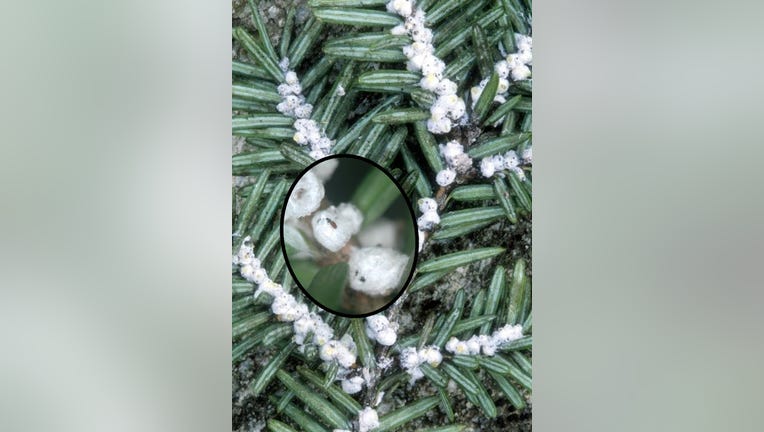Invasive, tree-killing hemlock woolly adelgid found in Ann Arbor; 1st confirmed spot on east side of state

Round, white hemlock woolly adelgid ovisacs are found on the undersides of branches near the base of the needles. Photo courtesy of Lorraine Graney, Bartlett Tree Experts, Bugwood.org.
ANN ARBOR, Mich. (FOX 2) - Hemlock woolly adelgid (HWA), invasive pests that kill trees, has been found in Ann Arbor – the first confirmed detection on the east side of Michigan.
It was discovered at Nichols Arboretum and confirmed by the Michigan Department of Agriculture and Rural Development (MDARD) on May 9.
"Our team of invasive species specialists is currently working with the arboretum to determine an appropriate treatment and response plan," said Mike Philip, MDARD’s Pesticide and Plant Pest Management Division Director. "There isn’t a way to determine how long hemlock woolly adelgid has been there or how it got there, but it’s possible HWA has been there for a number of years."
Washtenaw County is the seventh county to have a verified discovery. HWA detections have been found in Allegan, Benzie, Mason, Muskegon, Oceana, and Ottawa counties and have been within five miles of the Lake Michigan shoreline.
"Unlike western Michigan, where the other infestations are located, hemlock trees are not native to this region of the state," Philip said. "Although the pest still poses a problem for homeowners who may have planted hemlock trees or where they may have been planted in other landscaping, this HWA detection does not pose a significant threat to Washtenaw’s natural resources and environment."
HWA infestations look like tiny cotton balls at the base of hemlock needles on the underside of the branch.
Residents and park managers near the arboretum are encouraged to check their hemlock trees for hemlock woolly adelgid and if found, report it.
The insects do not move far on their own, but they can be blown by the wind or hitch a ride on humans and animals.
These pests suck sap from hemlock needles, killing the trees eventually. Typically, an infested tree will die in 4-10 years.
Dying trees can be a danger during storms and high winds. In forests, loss of hemlock trees can reduce shade, winter cover, food, and habitat for birds, fish, and mammals.
Tips for preventing the spread of HWA:
- Leaving firewood at home and buying it where you burn it.
- Staying on trails to protect natural areas.
- Parking in open, paved areas, not in fields or under trees.
- Cleaning gear and vehicles before hitting the road.
- Reporting suspected infestations by one of the following means: Email the Michigan Department of Agriculture and Rural Development at MDA-Info@Michigan.gov. Call the MDARD Customer Service Center at 800-292-3939 between 8 a.m. and 5 p.m., Monday through Friday. Use the Midwest Invasive Species Information Network (MISIN) online reporting tool. Download the MISIN smartphone app and report from your phone.
- Email the Michigan Department of Agriculture and Rural Development at MDA-Info@Michigan.gov.
- Call the MDARD Customer Service Center at 800-292-3939 between 8 a.m. and 5 p.m., Monday through Friday.
- Use the Midwest Invasive Species Information Network (MISIN) online reporting tool.
- Download the MISIN smartphone app and report from your phone.

